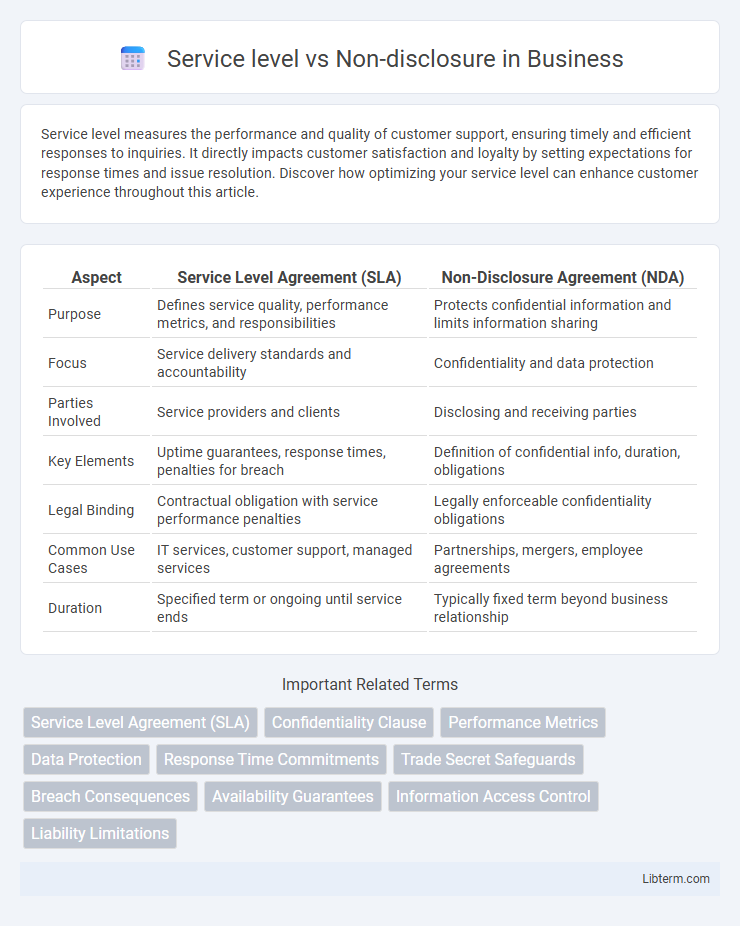Service level measures the performance and quality of customer support, ensuring timely and efficient responses to inquiries. It directly impacts customer satisfaction and loyalty by setting expectations for response times and issue resolution. Discover how optimizing your service level can enhance customer experience throughout this article.
Table of Comparison
| Aspect | Service Level Agreement (SLA) | Non-Disclosure Agreement (NDA) |
|---|---|---|
| Purpose | Defines service quality, performance metrics, and responsibilities | Protects confidential information and limits information sharing |
| Focus | Service delivery standards and accountability | Confidentiality and data protection |
| Parties Involved | Service providers and clients | Disclosing and receiving parties |
| Key Elements | Uptime guarantees, response times, penalties for breach | Definition of confidential info, duration, obligations |
| Legal Binding | Contractual obligation with service performance penalties | Legally enforceable confidentiality obligations |
| Common Use Cases | IT services, customer support, managed services | Partnerships, mergers, employee agreements |
| Duration | Specified term or ongoing until service ends | Typically fixed term beyond business relationship |
Understanding Service Level Agreements (SLAs)
Understanding Service Level Agreements (SLAs) involves clearly defining the expected performance and quality metrics between service providers and clients, ensuring accountability and measurable outcomes. SLAs typically outline response times, uptime guarantees, and resolution protocols, which are critical for maintaining trust and service continuity. Unlike Non-Disclosure Agreements (NDAs), which protect confidential information, SLAs focus on operational standards and service delivery commitments.
What is a Non-Disclosure Agreement (NDA)?
A Non-Disclosure Agreement (NDA) is a legally binding contract designed to protect sensitive information shared between parties during business relationships or collaborations. It clearly defines the scope of confidential data, obligations for maintaining secrecy, and the duration of the confidentiality obligations. NDAs are critical in safeguarding intellectual property, trade secrets, and proprietary information from unauthorized disclosure or use.
Key Differences Between SLA and NDA
Service Level Agreements (SLAs) define measurable performance standards and responsibilities between service providers and clients, focusing on service quality, availability, and response times. Non-Disclosure Agreements (NDAs) protect confidential information shared between parties, ensuring privacy and restricting unauthorized disclosure. The key difference lies in SLAs regulating service expectations while NDAs safeguard sensitive data confidentiality.
Purpose and Scope: SLA vs NDA
Service Level Agreements (SLAs) define the specific performance metrics, responsibilities, and standards that a service provider must meet, ensuring measurable service quality and availability. Non-Disclosure Agreements (NDAs) establish confidentiality obligations to protect sensitive information shared between parties, focusing strictly on information security rather than service delivery. The scope of SLAs encompasses service performance and customer expectations, while NDAs center exclusively on restricting information disclosure and safeguarding proprietary data.
Legal Implications: Service Level vs Non-Disclosure
Service level agreements (SLAs) establish measurable performance standards and obligations between parties, whereas non-disclosure agreements (NDAs) focus on the confidentiality of shared information, each carrying distinct legal implications. Breach of an SLA typically results in financial penalties or service credits, while violation of an NDA can lead to injunctions, damages, or reputational harm due to unauthorized disclosure of sensitive information. Understanding the specific legal remedies and enforcement mechanisms fundamental to SLAs and NDAs protects businesses from operational risks and confidentiality breaches.
Essential Components of an SLA
Essential components of a Service Level Agreement (SLA) include clear definitions of service scope, performance metrics, and responsibilities of both parties. Service levels specify measurable criteria such as uptime, response time, and resolution time, ensuring accountability and quality standards. Non-disclosure agreements (NDAs) often accompany SLAs to protect sensitive information exchanged during service delivery, maintaining confidentiality between the provider and the client.
Essential Clauses in an NDA
Service level agreements (SLAs) in an NDA specify measurable performance standards contractors must meet, ensuring reliability and accountability during service delivery. Essential clauses include confidentiality obligations, defining the scope of protected information to prevent unauthorized disclosure. Penalties for breaches and dispute resolution procedures safeguard service quality and maintain trust between parties.
When to Use an SLA or NDA
Service Level Agreements (SLAs) are essential when defining measurable performance standards and responsibilities between service providers and clients to ensure accountability and quality. Non-Disclosure Agreements (NDAs) are crucial for protecting confidential information and trade secrets during business negotiations or partnerships. Use an SLA when specifying deliverables and performance metrics, whereas an NDA is appropriate for safeguarding sensitive information before detailed discussions or collaborations.
Common Mistakes in Drafting SLAs and NDAs
Common mistakes in drafting Service Level Agreements (SLAs) include vague performance metrics and unclear penalty clauses, which lead to disputes and unmet expectations. Non-disclosure agreements (NDAs) often suffer from overly broad or ambiguous confidentiality terms that fail to specify the scope or duration of obligations, risking insufficient protection of sensitive information. Ensuring precise definitions, specific obligations, and tailored terms in both SLAs and NDAs enhances enforceability and alignment between parties.
Best Practices for Managing SLAs and NDAs
Effective management of Service Level Agreements (SLAs) and Non-Disclosure Agreements (NDAs) involves clearly defining performance metrics, confidentiality obligations, and compliance requirements to protect both parties. Best practices include regular monitoring of SLA performance indicators, ensuring legal reviews for NDA terms, and implementing automated tracking systems to promptly address breaches or lapses. Maintaining transparent communication channels and periodic audits enhances accountability and strengthens contractual enforcement.
Service level Infographic

 libterm.com
libterm.com